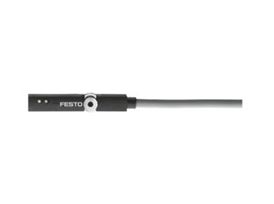FESTO (Festo) Proximity Switch SME - 8 - ZS - KL - LED - 24 Introduction
FESTO (Festo), as a renowned company in the field of automation technology, produces proximity switches that play a significant role in industrial automation systems. The SME - 8 - ZS - KL - LED - 24 proximity switch is characterized by high precision and reliability, allowing it to operate stably in complex industrial environments.
From an aesthetic perspective, it features a compact and robust housing design that is not only easy to install but also effectively withstands external physical impacts and harsh working conditions. The dimensions are carefully designed to fit into various confined spaces, offering greater flexibility for the layout of industrial equipment.
Electrical performance-wise, the SME - 8 - ZS - KL - LED - 24 employs advanced sensing technology, enabling rapid and accurate detection of the approach of target objects. It operates at a voltage of 24V, a common standard in the industrial sector, facilitating compatibility and connection with a wide range of industrial equipment. Additionally, the proximity switch is equipped with an LED indicator, allowing the operational status to be monitored intuitively, which is convenient for operators to conduct real-time monitoring and troubleshooting.
Applications of FESTO (Festo) Proximity Switch SME - 8 - ZS - KL - LED - 24
In automated production lines, the FESTO proximity switch SME - 8 - ZS - KL - LED - 24 has a wide range of applications. For instance, in material handling systems, it can be used to detect the position and quantity of materials. When materials approach the switch's sensing range, it immediately sends signals to control the operation of conveying equipment, achieving precise material transport and positioning. Such precise control can enhance production efficiency and reduce material waste.
In the field of mechanical processing, the proximity switch can be used to detect the position and status of cutting tools. In CNC machines, the accurate position of the tool is crucial for machining precision. The SME - 8 - ZS - KL - LED - 24 can monitor the tool's position in real-time, and when the tool approaches or leaves a specific position, it promptly relays signals to the control system, ensuring the accuracy and stability of the machining process.
In the packaging industry, proximity switches can be used to detect the position and quantity of packaging materials. During the operation of packaging machines, they can precisely monitor the conveyance of packaging materials, controlling the speed and size of packaging to ensure consistent packaging quality. Furthermore, in the field of warehouse logistics, the proximity switch can also be used to detect the storage location and inventory quantity of goods, achieving intelligent warehouse management.
Advantages and Maintenance Points of FESTO (Festo) Proximity Switch SME - 8 - ZS - KL - LED - 24
FESTO proximity
Proximity Switch SME-8-ZS-KL-LED-24 belongs to the Sensors series under FESTO company, model number SME-8-ZS-KL-LED-24. To purchase or inquire about Proximity Switch SME-8-ZS-KL-LED-24, you can directly contact 158 0047 0089 (Mr. He).



